Next Generation
Borg Cube
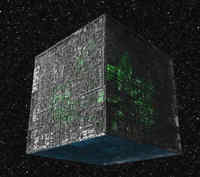
Borg Cube (VOY-168)
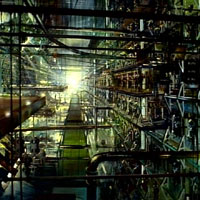
Borg Cube Interior (TNG-142)
A massive cube shaped spacecraft that was first encountered on Stardate 42762.2 near System J-25 in the Beta Quadrant by the USS Enterprise NCC-1701-D, thanks to Q. The Borg cube was one of the most formidable technologies known to the Federation in the late 24th century. Its lack of identifiable functional spaces, such as a bridge, engineering, or personnel quarters, revealed the hive-like Borg collective consciousness and its drones. It not only carried “smart” weaponry that adapted, but it could analyze an opponent’s weapons systems and adapt defenses within seconds.[1] On Stardate 43989.7, another Borg cube—sent to assimilate Earth and its technology—traveled to the Alpha Quadrant using a transwarp conduit to make their journey and was briefly led by Locutus, the assimilated Captain Jean-Luc Picard.[2] Another cube tried to assimilate Earth in 2373, but was destroyed by a concentrated barrage from a Starfleet armada. It ejected a smaller sphere which created a time vortex in an attempt to travel back in time and assimilate Earth in 2063, preventing First Contact between Humans and Vulcans.[3]
References
- 1. “Q Who?” Star Trek: The Next Generation, Episode 142. Television. 8 May 1989.
- 2. “The Best of Both Worlds.” Star Trek: The Next Generation, Episode 174. 18 June 1990.
- 3. Star Trek: First Contact. Star Trek: The Next Generation. 22 November 1996.
U.S.S. Bonestell NCC-31600
One of 39 Federation starships destroyed by the Borg during the Battle of Wolf 359.[1]
References
U.S.S. Avenger
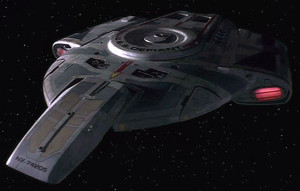
Defiant class (DS9-537)
On Stardate 53550.8, Ambassador Worf‘s Starfleet commission was temporarily reactivated and he was given command of the Defiant-class Starship Avenger; the ship was ordered to Outpost 40 in the Briar Patch so that he could negotiate with the Son’a, who were once again threatening Starfleet’s presence in the area. When talks broke down, the Avenger helped defend the outpost from a Son’a attack fleet and successfully repelled them.[1]
› Continue reading
Constitution Class
Original Configuration
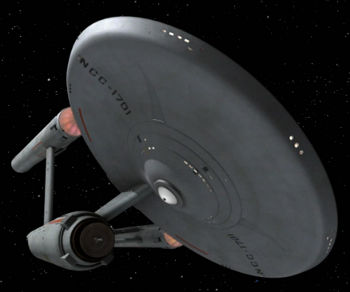
Constitution class (TOS-10)
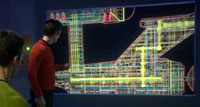
Constitution class MSD (ENT-95)
| Length | 289 meters |
| Width | 127 meters |
| Height | 73 meters |
| Decks | 23 |
| Mass | Mk. I: 162,425 metric tons Mk. II: 164,400 metric tons Mk. III: 167,900 metric tons |
| Crew Complement | 430 |
| Evacuation Limit | 320 |
| First Commissioned | 2245 |
| Weapons | 6 Type-V phaser banks, 2 torpedo launchers, photon torpedoes |
| Defenses | Deflector shields |
| Cruising Speed | Warp 6 |
| Maximum Cruise Speed | Warp 7 |
| Maximum Rated Speed | Warp 8 for 12 hours |
Refit Configuration
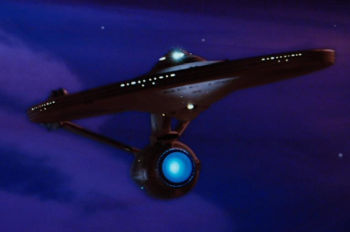
Constitution class refit (ST-02)
| Length | 305 meters |
| Width | 131 meters |
| Height | 74 meters |
| Crew Complement | 416 |
| Evacuation Limit | 240 |
| First Commissioned | 2273 |
| Weapons | 12 Type-VI phasers in 6 banks; 3 torpedo launchers, photon torpedoes |
| Defenses | Deflector shields |
| Cruising Speed | Warp 6 |
| Maximum Cruise Speed | Warp 8 |
| Maximum Rated Speed | Warp 10 for 12 hours |
The Constitution class cruisers are among the most renowned vessels of their time. Serving as both a research vessel and a cruiser, these ships performed their duties to perfection for the majority of the 23rd century. The Constitution class ships were an integral part of the buildup during “The Great Awakening,” from the outset the most versatile of all ships built for the expansion efforts. class starships included the acclaimed U.S.S. Enterprise NCC-1701.[1] During the time of Captain James T. Kirk’s celebrated first five-year mission of exploration, only twelve of these ships were in existence.[2] Constitution class starships used duotronic computers, based on designs developed by Dr. Richard Daystrom in 2243.[8]
› Continue reading
Vulcan
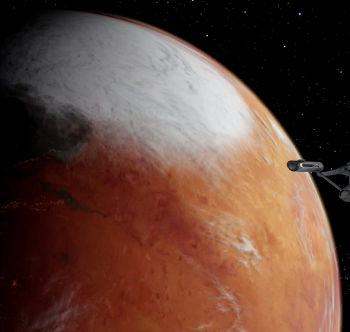
Vulcan (TOS-34)
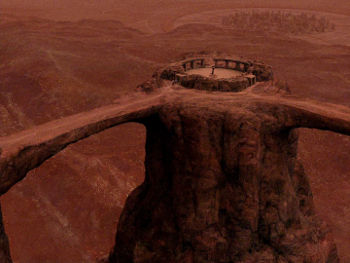
Vulcan surface (TOS-34)
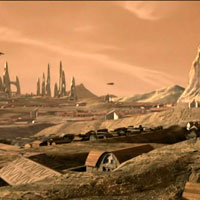
Vulcan surface (ENT-79)
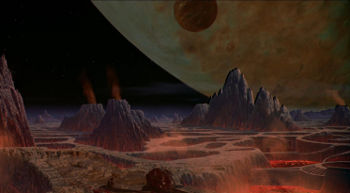
Vulcan Surface (ST-01)

Vulcan Surface (ST-01)
Vulcan, a Class-M world,[2, 4] was the second planet in the 40 Eridani trinary system, orbiting 40 Eridani A.[4] Although Vulcan had no moon,[1] the planet shared an orbit with its sister world, T’Khut.[3]
› Continue reading
Utopia Planitia Fleet Yards
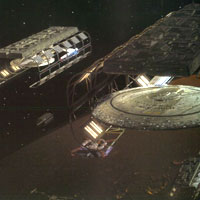
Utopia Planitia Ship Yards (VOY-218)
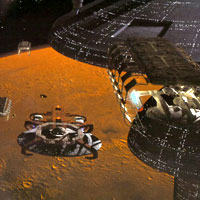
Utopia Planitia Ship Yards (VOY-218)
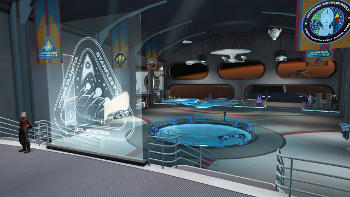
Utopia Planitia Ship Yards interior (STO)
Shipbuilding facility orbiting the planet Mars,[2] with offices on the surface in the Utopia Planitia region.[1]
› Continue reading
Trillius Prime
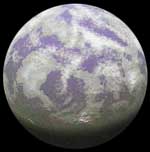
Trillius Prime (STSC)
Trillius Prime, also known simply as “Trill,” was a Class-M planet in the Kalandra Sector of the Alpha Quadrant.[3] Travis Mayweather visited Trillius Prime as a teenager.[2] The Caves of Mak’ala were a series of underground caverns that extended for several kilometers, with pools in which the unjoined symbionts resided while awaiting hosts and were cared for by the Guardians.[1]
References
- 1. “Equilibrium.” Star Trek: Deep Space Nine, Episode 450. Television. 17 October 1994.
- 2. “Broken Bow.” Star Trek: Enterprise, Episodes 01-02. Television. 26 September 2001.
- 3. Star Trek: Star Charts. Book. 2002. Pocket Books.
Starbase 9

Starbase 9 (TOS DC v2 73)
Originally a supply station constructed in the 2180s, Starbase 9 slowly became a major scientific and astronomical monitoring station — the Argus Array, for example, was designed as an “uprated” model of Starbase 9’s orbital phased EM collectors.[2]
The U.S.S. Stargazer NCC-2893 was towed to this starbase after the U.S.S. Enterprise NCC-1701-D received the old vessel from the Ferengi in 2364.[1]
References
- 1. “The Battle.” Star Trek: The Next Generation, Episode 110. Television. 16 November 1987.
- 2. “Starfleet Operations Manual.” Star Trek Roleplaying Game, Book 3. Game. 2003. Decipher, Inc.
Sol System
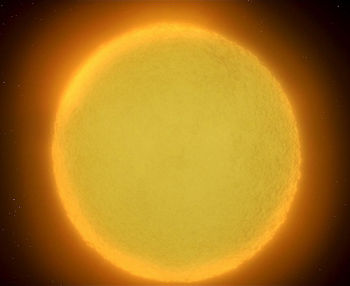
Sol (ST-04)
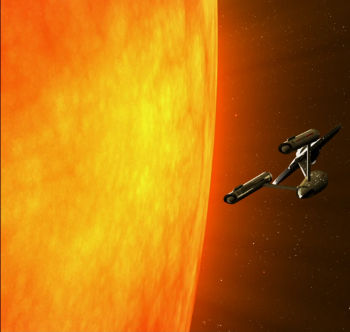
Sol (TOS-21)
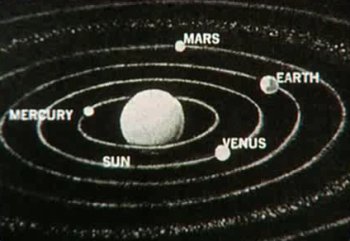
Sol System (TOS-00)
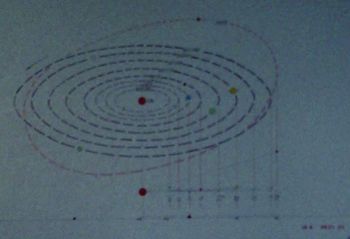
Sol System (TOS-37)
Star system located in Sector 001, in the Alpha Quadrant. The parent star, Sol, was Type-G and was orbited by eight planets (though Pluto frequently switched between being considered a planet and a planetoid),[2] including Earth, and was commonly known as the Sun. The Talosians viewed an image of the Sol System and many images of Earth’s history while accessing the U.S.S. Enterprise NCC-1701‘s computer in 2254.[1]
Planets
References
- 1. “The Cage.” Star Trek, Episode 0. Television. 1965 (Unaired).
- 2. “Before Dishonor.” Star Trek: The Next Generation. Novel (Unnumbered). November 2007.
San Francisco Fleet Yards
Shipbuilding facility orbiting the planet Earth, with offices on the surface in San Francisco, California. Several ships were built there, including:
- Enterprise NX-01[6]
- U.S.S. Enterprise NCC-1701[1]
- U.S.S. Enterprise NCC-1701-A[3]
- U.S.S. Enterprise NCC-1701-E[5]
- U.S.S. Excelsior NCC-2000[2]
- U.S.S. Sutherland NCC-72015[4]
References
- 1. “The Cage.” Star Trek, Episode 00. Television. 1965 (Unaired).
- 2. Star Trek III: The Search for Spock. Film. 1 June 1984.
- 3. Star Trek IV: The Voyage Home. Film. 26 November 1986.
- 3. “Redemption, Part II.” Star Trek: The Next Generation, Episode 201. Television. 23 September 1991.
- 5. Star Trek: First Contact. Film. 22 November 1996.
- 6. “Broken Bow.” Star Trek: Enterprise, Episodes 01-02. Television. 26 September 2001.
Categories
- Animated Series (60)
- Articles (28)
- Books (447)
- Cast & Crew (79)
- Comics (22)
- DS9 (328)
- Early Voyages (125)
- Education (5)
- Enterprise (373)
- Excelsior (36)
- Food (19)
- Games (223)
- Klingon (70)
- Library (1,543)
- Logs (593)
- Lost Era (55)
- Medicine (18)
- Merrimac (1)
- Mirror (35)
- Miscellaneous (13)
- New Frontier (54)
- Next Generation (635)
- Original Series (681)
- Personnel (436)
- Places (369)
- Politics (12)
- Recreation (10)
- SCE (41)
- Science (1)
- Shatnerverse (9)
- Ships (455)
- Site Updates (98)
- Starfleet Academy (86)
- Stargazer (42)
- STO (61)
- Technology (45)
- Titan (59)
- To Boldly Go (1)
- TV/Film (214)
- Uncategorized (4)
- Vanguard (76)
- Voyager (236)
- Weapons (27)
- Xenology (54)